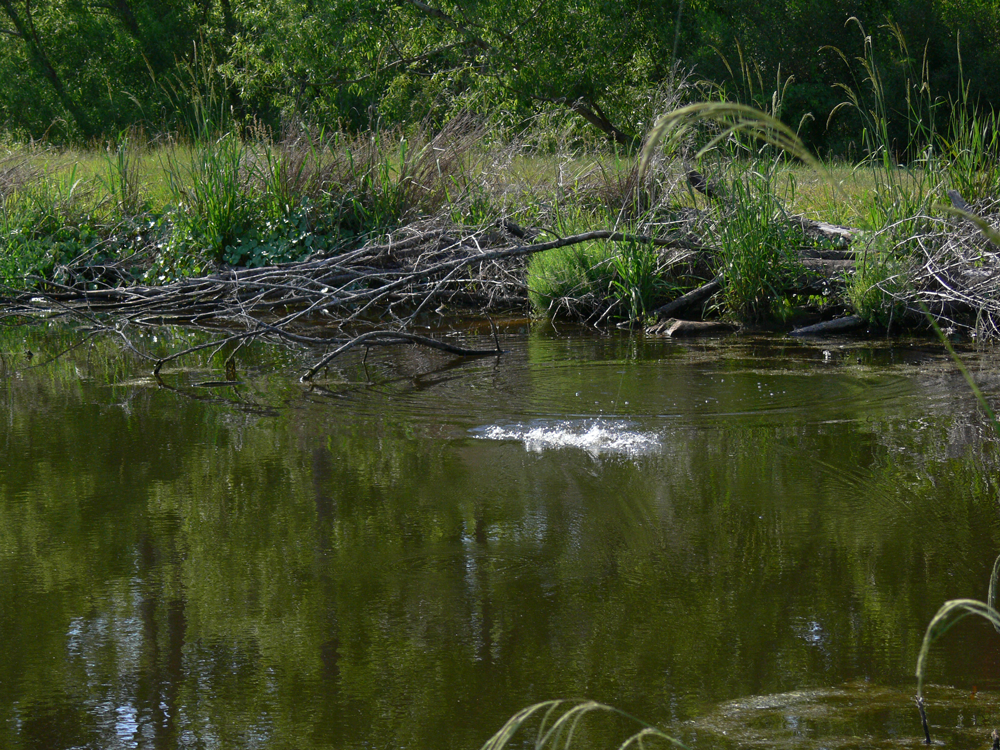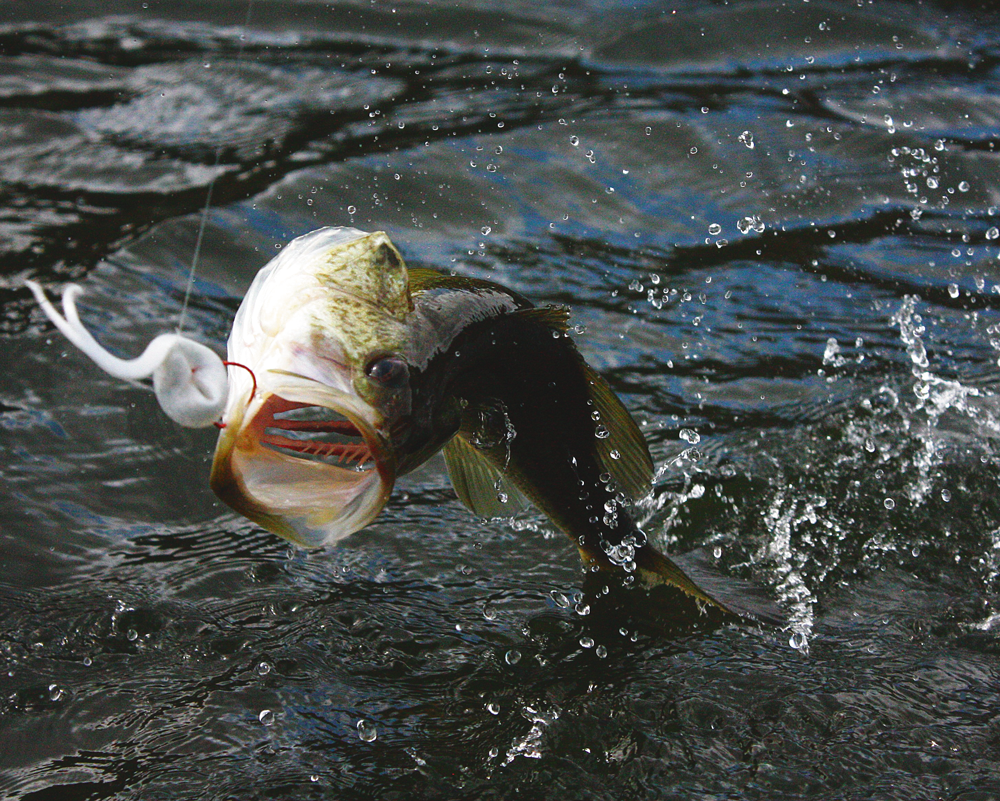It’s not bedtime for anglers who want some fine sight bed fishing for bass action
The sun had risen some hours before, but the angler in the bass boat was still working hard. The trolling motor held the boat about 60 feet off the shallow shoreline of a big creek channel that feeds into the main body of the lake. The angler was standing and diligently watching the water near the shore as he slowly moved down the creek.
All at once, he stopped the motor and made a quick cast. His search paid off. The round depression he had been looking for in the sandy bottom was being guarded by a nice 3-pound bass.
The angler let the soft plastic creature lure sink and then moved the ugly creature into the territory of the patrolling bass. It took a slight jerk to move the lure into the round depression, but the bass couldn’t stand the intruder any longer. A vicious strike and the angler’s line tightened with a very angry bass trying its best to get free.
After a short, but very energetic fight, the angler lifted the still-upset bass into the boat and carefully removed the lure. The bass finned at boat side for just a moment when it was released. Then it sped directly back to its post of duty, the round depression in the sandy bottom.
The angler took a short drink of cold water, wiped his brow and resumed his position on the bow of the bass boat to resume his midday hunt for more bedding bass.

Look for bedding bass near underwater wood structure. Photo by Ed Mashburn
Where to Find Bedding Bass
Lake Guntersville is probably the best-known lake in Alabama when it comes to catching lunker largemouth bass. In fact, it is one of the most famous bass lakes in the world. So, people might say Lake Guntersville sets the pattern for the entire state. What works on Guntersville will probably work on most Alabama lakes when it comes to targeting bedding bass.
Capt. Tim Chandler, a well-respected guide on Lake Guntersville, offers some good advice when it comes to finding bedding bass.
He says, “Typically, bass beds will mostly be in bays and creeks off the main river areas. The bass beds will be right up near the bank, from eight inches of water out to about three feet. You can’t see the beds deeper than that, but there will be bedding bass in deeper water, too.”
Furthermore, Captain Tim says, “Bass love old wood such as logs and stumps. They’ll rub against solid stuff like wood when they’re spawning. Usually, you’ll see a 1- to 2-foot wide depression on the bottom. It will look like a big old pothole from paper plate size to manhole cover size. They’ll even move mussel shells to help make their beds. Many beds on Lake Guntersville will have little mussel shells in them.”
When asked the most important element of locating bass beds, Chandler says that anglers need to look for a solid bottom. He says that bass love sandy bottoms. Sand makes a hard underwater surface and the bedding bass love the hard bottom. It’s a waste of time usually to look over soft, mucky bottoms for bass beds. They just won’t be there.
Keep another important point in mind when it comes to sight fishing for spring bass. Although the grass in Guntersville won’t be anywhere near its full summer growth, it can be well on its way to becoming a major factor in bass fishing during the spawning season.
Tim Chandler says that if an angler can locate new growing milfoil with a sandy bottom, the bass beds will be easier to spot. The dark background of the growing milfoil contrasts with the cleared bass beds and really shows the beds and bass well.
What Lures and Rigs to Use
When sight fishing for bass beds, it’s important to keep in mind that we’re not trying to “match the hatch” and use lures that resemble what the bedding bass are eating. Many experts feel that bedding bass don’t eat much of anything while on the beds, especially when actively spawning.
Instead, anglers need to pick lure choices and presentations that put something in front of the bedding bass that just looks like it is not supposed to be there. Make it look like something that might threaten the eggs or fry in the bed or disrupt the spawning.
Captain Tim tells us, “A lot of folks use jigs. The colors don’t matter so much. Just use colors that are easy to see when the bass bite.”
White, chartreuse, even bright bubble-gum pink can be effective bedding lures. The fish can easily see them. Frequently, the angler can see when the bass takes the lure. The bright color just disappears when the bass takes it in its mouth. Then, the angler can set the hook.
Besides jigs, big lizards, tubes, creature lures and Senko-type worms all work well in spring bedding situations. Chandler particularly recommends the Big Bite Baits Trick Stick soft plastic worm for bedding fishing.
Chandler says, “So many baits can be used to catch bedding bass, but keep in mind that bass will respond, or not respond, to different baits. You need to try different styles and colors on fish that don’t respond at first. This helps establish a pattern for the day.”
Regardless of the lure choice, anglers need to keep in mind that not every bass seen will be willing to strike, at least not all of the time. Chandler advises, “If the bass are locked on, spawning or guarding the bed, anglers can get within 10 feet of them. However, before they’re locking on, they’ll swim off if anyone gets too close to them, but they’ll come right back. Don’t target the spooky fish. Cast to the fish that stay on the bed. If the bass stays on the bed and reacts to the lure, even something as trivial as fins waving or a slight movement toward the lure, that fish can be caught. Fish that don’t react at all will be much harder to catch.”
Anglers who sight fish the beds will usually be able to use either spinning or bait-casting gear, whichever they prefer. If flipping jigs, the level wind rig works better. However, spinning gear will allow anglers to use lighter line. Sometimes in very clear water, line as light as 10-pound-test may be needed to fool spooky fish. Many anglers use fluorocarbon, which can make a difference when fishing for bedding bass. Captain Tim highly recommends Sunline Shooter brand as being good. Fluoro line is harder for fish to see, has good abrasion resistance and less line-stretch when setting the hook.

Bright soft plastics like this white fluke account for many spring bedding bass. Photo by Ed Mashburn
When to Find Bedding Bass
Bass live their lives in close connection with the temperature of the water around them. When the water starts to warm after the winter chill, bass will start to think about heading to the bedding areas. Although some bass will be in a prespawn pattern when the water is still in the 50s, the biggest rush of bedding bass will occur after the water temperatures reach the 60s. These temperatures are dictated by rainfall, length of day and amount of sunshine warming the water.
An old timer once told us, “When the dogwoods bloom and oak leaves are the size of a squirrel’s ear, the bass will be on the beds.” While that old saying is very likely true, on Lake Guntersville, in particular, it is possible to predict the bass spawn more precisely.
Tim Chandler observed, “It’s all about water temperature. It has nothing to do with anything else. On Guntersville, by the second week of April, it’s on! The bad weather is over. I’ve seen bedding start as early as the second week of March in the upper parts of the lake.”
So visiting anglers who want to get on Lake Guntersville to sight fishing for bedding bass can almost set their calendars. Early April would be a good time to book a trip.
Captain Tim makes a point of saying that bass anglers who are sight fishing the beds on Guntersville will very rarely actually see the biggest bass on their beds. He says, “When we sight fish the beds, we see fish from 1.5 to six pounds. We usually do not see the 7-pound or better bass on their beds. The really big bass bed deeper, usually in four to six feet of water where they are not visible. We still catch these big ones while they’re bedding, but we don’t sight fish the big ones.”
Best Advice from an Expert
Captain Tim has been in the bass fishing game for a long time and he has seen several bedding seasons come and go. He has some very good advice for anglers who want to try to get into the sight fishing game for bedding bass.
Captain Tim says, “Come on up. Work your way around the bank with your trolling motor. Just keep looking into the water. By the way, a good pair of polarized sunglasses is crucial to help see the beds and the fish. When you see a good bass, if it won’t bite right then, mark the spot either visually or on your GPS and come back later. You can probably catch that fish you can see.”
Patience is absolutely required when it comes to bed fishing for bass. Captain Tim says. “It may take 30 minutes to an hour of casting to catch a certain fish you can see, but I’ve also seen them caught on the very first cast. Don’t target the spooky fish, the ones that run off the bed. If the bass you can see stays on the bed, that fish can be caught. If the fish refuses to react in any way to the lure, that fish will be much harder to catch.”
Finally, Captain Tim says, “Bed fishing for bass—you’ll either love it or hate it!”
Important Contact Information:
Captain Tim Chandler
tchandler@mildrillafishing.com
256-655-8292
Big Bite Baits
877-222-7429
Sunline Fishing Line
310-538-6887
